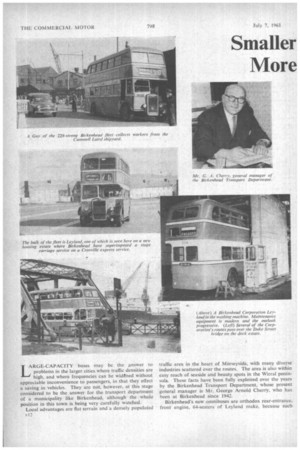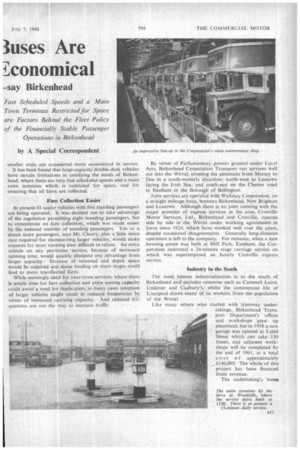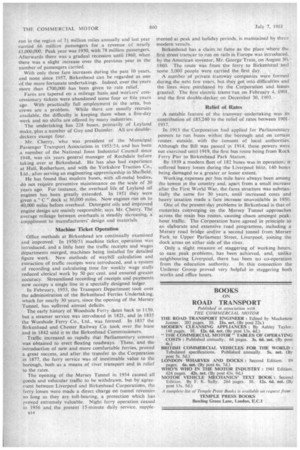Smaller 3uses Are More
Page 46

Page 47

Page 48

If you've noticed an error in this article please click here to report it so we can fix it.
-Fconomical
-say Birkenhead
LARGE-CAPACITY buses may be the answer to problems in the larger cities where traffic densities are high, and where frequencies can be widened without appreciable inconvenience to passengers, in that they effect a saving in vehicles. They arc not, however, at this stage considered to be the answer for the transport department of a municipality like Birkenhead, although the whole position in this town is being very carefully watched.
Local advantages are flat terrain and a densely populated
E I 2
traffic area in the heart of Merseyside, with many diverse industries scattered over the routes. The area is also within easy reach of seaside and beauty spots in the Wirral peninsula. These facts have been fully exploited over the years by the Birkenhead Transport Department, whose present general manager is Mr. George Arnold Cherry, who has been at Birkenhead since 1942.
Birkenhead's new omnibuses are orthodox rear-entrance, front engine, 64-seaters of Leyland make, because such smaller units are considered more economical in service.
It has been found that large-capacity double-deck vehicles have certain limitations in satisfying the needs of Birkenhead, where there are very fast scheduled speeds and a main town terminus which is restricted for space, and for ensuring that all fares are collected.
Fare ColleCtion Easier At present 61-seater vehicles with five standing passengers are being operated. It Was decided not to take advantage of the regulation permitting eight standing passengers, but to concentrate on fare Collection, which was made. easier by the reduced number of standing passengers. Ten or a dozen more passengers, says Mr. Cherry, plus a little more care requiredlor manceuvring larger vehicles, would make requests for more running time difficult to refuse. An extra vehicle on any particular service, because of increased running time, would quickly dissipate any .advantage from larger capacity. Increase of terminal and depot space would be required and dense loading on short stages Could lead to more uncollected fares.
While seemingly ideal for inter-town services, where there is ample time for fare collection and extra. seating .capacity could avoid a need for duplication, in many cases adoption of larger vehicles might result • in • reduced frequencies by virtue of increased carrying capacity. And reduced frequencies are not the way to increase traffic.
By virtue of Parliamentary powers granted under Local Acts, Birkenhead Corporation Transport run services well out into the Wirral, crossing the peninsula from Mersey to Dee in a south-westerly direction; north-west to Leasowe facing the Irish Sea; and south-east on the Chester road to Eastham ,in the Borough of Bebington.
Joint services arc operated with Wallasey. Corporation, on a straight mileage basis, between Birkenhead, New Brighton and Leasowe. Although there is no joint running with the major provider of express services in the area, Crosville Motor Services, Ltd.; Birkenhead and Crosville, operate side by side in the Wirral under working agreements in force since 1924, which have worked well over the years, despite occasional disagreements. Generally long-distance operation is left to the company. For instance, when a new housing estate was built at Mill Park, Eastharn, the Corporation instituted a 24-minute stage carriage service on which was superimposed an hourly Crosville express service.
Industry in the South The most intense industrialization is to the south of Birkenhead and includes concerns such as 'Cat-rumen Laird, Unilever and Cadbury's, whilst the commercial life of Liverpool draws many of its workers from the population of the Wirral.
Like many others who started with tramway under takings, Birkenhead Transport Department's offices and workshops grew up piecemeal, but in 1958 a new garage was opened at Laird Street which can take 150 buses, and adjacent workshops will -be completed by the end of 1961, at a total C ost of approximately £140,000. The whole of this project has been financed from revenue.
The undertaking's buses run in the region of 74 million miles annually and last year carried 66 million passengers for a revenue of nearly £1,000,000. Peak year was 1950, with 78 million passengers. Afterwards there was a gradual recession until 1960, when there was a slight increase over the previous year in the number of passengers carried. With only three fare increases during the past 10 years. and none since 1957, Birkenhead can be regarded as one of the more fortunate undertakings. Indeed, over the years more than £700,000 has been given to rate relief.'
Fares are tapered on a mileage basis and workers' concessionary tickets were abandoned some four or fie years ago. With practically full employment in the area, bus crews are a problem. While there are usually recruits available, the difficulty is keeping them when a five-day week and no shifts are offered by many industries.
The undertaking has 228 buses, primarily of Leyland make, plus a number of Guy and Daimler. All are doubledeckers 'except four.
Mr. Cherry, who was president of the Municipal Passenger Transport Association in 1953/54, and has been a member of the National Joint Industrial Council since 1948, was six years general manager of Rochdale before taking over at Birkenhead. He has also had experience at Hull. Rotherham, and with the Yorkshire Traction Co., Ltd., after serving an engineering apprenticeship in Sheffield.
He has found that modern buses, with all-metal bodies, do not require preventive maintenance on the scale of 20 years ago. For instance, the overhaul life of Leyland oil engines has been greatly extended. In 1951 they were given a " C " dock at 30.000 miles. Now engines run on to 40,000 miles before overhaul. Detergent oils and improved engine design are mainly responsible, says Mr. Cherry. The average mileage between overhauls is steadily increasing, a corppliment to manufacturers' design and Materials.
Machine Ticket Operation Office methods at Birkenhead are continually examined and improved. In 1950/51 machine ticket,operation Was introduced, and a little later the traffic receipts and wages departments merged. machines being installed for detailed figure work. New methods of waybill calculation and extraction of traffic receipts were introduced, and a system of recording and calculating time for weekly wage staffs reduced clerical work by 50 per cent. and ensured greater accuracy. Streamlined recording of receipts and payments now occupy a single line in a specially designed ledger.
In February, 1953, the Transport Department took over the administration of the Birkenhead Ferries Undertaking, which for nearly 30 years, since the opening of the Mersey Tunnel, has suffered annual deficits.
The early history of Woodside Ferry dates back to 1150. but a steamer service was introduced in 1821, and in 1835 the Woodside Ferry Co., Ltd., was formed. In 1837 the Birkenhead andChester Railway Co. took over the lease and in 1842 sold it to the Birkenhead Commissioners.
Traffic increased so rapidly that Parliamentary consent was obtained to erect floating roadways. These, and the introduction of new and more comfortable ferries, proved a great success, and after the transfer to the Corporation in 1877, the ferry service was of inestimable value to the borough, both as a means of river transport and in relief to the rates.
The opening of the Mersey Tunnel in 1934 caused all goods and vehicular traffic to be withdrawn, but by agreement between' Liverpool and Birkenhead Corporations, the ferry losses were made a direct charge on tunnel revenues so long as they are toll-bearing, a protection which has prov,ed extremely valuable. Night ferry operation ceased in 1956 and the present 15-minute daily service, supple 814 mented at peak and holiday periods, is maintained by three, modern vessels.
Birkenhead has a claim to fame as the place where the first street tramcar to run on rails in Europe was introduced. by the American inventor, Mr. George Train, on August 30-, 1860. The route was from the ferry to Birkenhead and ' some 5,000 people were carried the first day.
A number of private tramway companies were formed during the next few years, but they got, into difficulties and the lines were purchased by the Corporation and leases granted. The first electric trams ran on February 4, 1901, and the first double-decker on December 30, 4903.
Relief of Rates • A notable feature of the tramway undertaking was its contribution of 1,85,240 to the relief of rates between 19011937.
In 1913 the Corporation had applied for Parliamentary powers to run buses within the borough and on certain routes outside, with the consent of local authorities. Although the Bill was passed in 1914, these powers were not exercised until 1919, the first bus route being from Rock Ferry Pier to Birkenhead Park Station.
By 1939 a modern fleet of 182 buses was in operation; it suffered heavy losses during the Liverpool blitz, 140 buses being damaged to a greater or lesser extent.
Working expenses per bus mile have always been among the lowest in the country and, apart from a small increase after the First World War, the fares structure was substantially the same for 30 years, until increased costs and heavy taxation made a fare increase unavoidable in 1950.
One of the present-day problems in Birkenhead is that of motorists converging On the Mersey Tunnel approaches across the main bus routes, causing chaos amongst peakhour traffic. The Corporation have agreed irt principle to an elaborate and extensive road programme, including a Mersey road bridge and/or a second tunnel from Mersey Park to Upper parliament Street, Liverpool, joining the dock areas on either side of the river.
Only a slight measure of staggering of working hours, to ease peak problems, has been achieved, and, unlike neighbouring Liverpool, there has been no co-operation
from the education authority. In this connection the Unilever Group proved very helpful in staggering both works and office hours.




















































































































